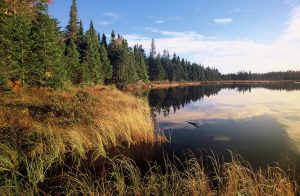
Source Forest Harvest Allocation Maps 24 May 2017;
red arrow inserted to highlight blocks near the Gully Lake Wilderness Area for which clearcuts were proposed initially.
(Click on image to enlarge it.)
On Friday May 26, this explanation was sent out to subscribers to notices from the Harvest Plant Map Viewer:
The Harvest Plan Map Viewer was updated May 24, to repair a posting error related to harvest plan PI173495, located adjacent to the Gully Lake Wilderness Area. This proposed harvest plan is in fact a partial harvest treatment, as determined through the pre-treatment assessment (PTA) process, but was posted as a clearcut due to a GIS input error. As this area was of great concern to the public, DNR felt it necessary to update the map immediately after discovering the error, rather than to wait until the next scheduled update of the HPMV.
The partial harvest prescription will be a uniform shelterwood which is a harvesting method that uniformly thins mature overstory trees throughout the forest, removing approx. 30% of the timber, in order to increase availability of sunlight to forest floor aiding in natural seedling regeneration of desired species; sugar maple and yellow birch in this case.
We thank you for your ongoing interest related to Crown land forest management, and appreciate the thoughtful concerns brought forward by some which aided in the discovery of this posting error.
There is some skepticism about this explanation amongst critics of NSDNR’s cutting practices who think the sudden reversal had more to do with press coverage of the planned clearcut and some heat related to the upcoming election. Regardless, the change is welcomed.
However, it should be noted that while a uniform shelterwood cut is definitely one step better than a 1-stage clearcut, it is still being conducted in the context of even-aged management:
So it is essentially a 2-stage (or possibly 3-stage) clearcut. This means that once the mature trees are finally cut, those blocks will lack the older forest features needed for some wildlife species. I would think that some type of selection cut would be more appropriate close to the borders of forested protected area such as Gully Lake – or perhaps staggering shelterwood cuts on adjacent, small blocks over longer periods, e.g. 50 years.Shelterwood harvesting is an even-aged system used to establish and develop desirable natural regeneration. By removing a mature stand in two to three cuts over five to 20 years, more sunlight reaches the forest floor to stimulate seedling development. The overstory provides seed and shelter for seedlings that can grow under partial shade. SOURCE The shelterwood harvesting system (NSDNR document)
Perhaps such an option has been considered and shelterwood harvests were chosen as a compromise between clearcuts and selection cuts. i.e. between the demands or needs of industry, and the needs of the forests and wildlife. Compromises of that sort are sometimes called “a balanced approach” or are reached by consensus. However, consensus on its own cannot guarantee that all is OK and compromises applied to natural systems can be highly destructive of both nature and the associated industry as we [should have] learned from the collapse of the cod fishery.
In their review of the circumstances that led to that collapse, Hutchings and Myers describe how the “overly optimistic” growth rate assumptions for cod (not shared by all scientists) led to markedly increased industrial and government investment, including a financial restructuring of the offshore trawler industry…This activity fuelled a socioeconomic and political optimism on the fishery that possessed considerable momentum” and led ultimately to collapse of the fishery. Had the decision makers applied a precautionary approach*, we would still have a cod fishery today.
The analogy to forestry seems pretty obvious.
——————–
*”The precautionary principle (or precautionary approach) to risk management states that if an action or policy has a suspected risk of causing harm to the public, or to the environment, in the absence of scientific consensus (that the action or policy is not harmful), the burden of proof that it is not harmful falls on those taking that action.
“The principle is used by policy makers to justify discretionary decisions in situations where there is the possibility of harm from making a certain decision (e.g. taking a particular course of action) when extensive scientific knowledge on the matter is lacking. The principle implies that there is a social responsibility to protect the public from exposure to harm, when scientific investigation has found a plausible risk. These protections can be relaxed only if further scientific findings emerge that provide sound evidence that no harm will result.”

